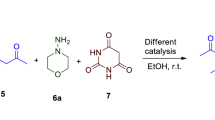Abstract
The present study describes a new way of preparing pyrazolidine by intramolecular Raschig amination using 1,3-diaminopropane and sodium hypochlorite. A global process has been developed, involving the characterization of the reaction mechanisms, kinetic studies and the optimization of the synthesis parameters. The rates were determined as a function of the reagent concentrations, pH and temperature. The overall reaction, of the first order with respect to both reagents, is the result of two successive mechanisms: the first being pH independent, the second accelerated by increasing pH. The bimolecular rate was simulated as a function of hydroxide ion activity. The activation enthalpy and entropy of the molecular process were established at 25 °C. A kinetic model is proposed and then validated by the experimental results. Finally, it was found that the yield of pyrazolidine essentially depends on the ratio p ([1,3-diaminopropane]0/[sodium hypochlorite]0) of the initial molar concentrations and the ratio of the rates k2/k1 (k1: rate of the N,N-dichloro-1,3-diaminopropane formation and k2: rate of N-chloro-1,3 diaminopropane formation).







Similar content being viewed by others
References
Ahn JH et al (2007) Synthesis, biological evaluation and structural determination of beta-aminoacyl-containing cyclic hydrazine derivatives as dipeptidhyl peptidase IV (DPP-IV) inhibitors. Bioorg Med Chem Lett 17(9):2622–2628
D’Andrea S et al (2005) Synthesis and antibacterial activity of dihydro-1,2-oxazine and 2-pyrazoline oxazolidinones: novel analogs of linezolid. Bioorg Med Chem Lett 15(11):2834–2839
Brugel TA et al (2006) Convergent synthesis of 2,3-bisarylpyrazolones through cyclization of bisacylated pyrazolidines and hydrazines. Tetrahedron Lett 47(19):3195–3198
Hans N et al (1994) Process for producing 4,5-diamino pyrazole derivatives, their use for colouring hair and noval pyrazole derivatives. European Patent EP 0618902
Leila H (2006) Composition for dyeing keratinic fibres comprising a diamino-N,N-dihydro-pyrazolone derivative, a coupling agent and a heterocyclic direct dye. European Patent EP 1733715
Luttringhaus A, Jander J, Schneider R (1959) Cyclic hydrazines from α, ω-diamines. Chem Ber 92:1756–1765
Crawford RJ, Mishra A, Dummel RJ (1966) The synthesis and physical properties of some 1- and 2-pyrazolines. J Am Chem Soc 88(17):3959–3963
Hasegawa Y et al (1998) A process for producing alicyclic hydrazine derivatives. European Patent EP 0850930
Martin BD (1959) Pyrazolidines. I. 1,2-diarylpyrazolidines, Graduate college of the university of Illinois, in partial fulfillment of the degree of Master of science
Weil I, Morris C (1949) Kinetic studies on the chloramines. 1. The rates of formation of monochloramine, N-chlormethylamine and N-chlordimethylamine. J Am Chem Soc 71(5):1664–1671
Elkhatib M (1994) Thèse de Doctorat d’Etat ès Sciences, Université Lyon 1. N° 89-94
Ferriol M, Abraham R, Delalu H, Cohen-Adad MTS (1982) Kinetics of monomethylhydrazine formation from monochloramine and methylamine. J Chem Phys 79(10):726
Ferriol M (1983) Préparation de la monométhylhydrazine par application de la synthèse Raschig. Thèse de doctorat d’état ès sciences, Université Lyon 1. N° 83-30
Darwich C, Elkhatib M, Pasquet V, Delalu H (2013) Kinetic and mechanistic study of N-aminopiperidine formation by the Raschig process. Kin. Cat. 54(6):649–655
Akerlof G, Kegeles G (1939) The density of aqueous solutions of sodium hydroxide. J Am Chem Soc 61(5):1027–1032
Akerlof G, Kegeles G (1940) Thermodynamics of concentrated aqueous solutions of sodium hydroxide. J Am Chem Soc 62(3):620–640
Anbar M, Yagil G (1962) The hydrolysis of chloramine in alkaline solution. J Am Chem Soc 84(10):1790–1796
Anbar M, Yagil G (1964) Formation of peroxynitrite by oxidation of chloramine, hydroxylamine, and nitrohydroxamate. J Inorg Nucl Chem 26(3):453
Lunn G, Sansone EB, Keefer LK (1984) Reduction of nitrosamines with aqueous titanium trichloride: convenient preparation of aliphatic hydrazines. J Org Chem 49(19):3470–3473
Delalu H, Marchand A, Ferriol M, Cohen-Adad R (1981) Kinetics of unsymmetrical dimethylhydrazine (UDMH) formation from monochloramine and dimethylamine. J Chim Phys 78(3):247–252
Cohen-Adad R, Delalu H, Marchand A, Mauge R (1987) Process for the synthesis of N-amino-aza-3-bicyclo(3,3,0) octane. Oril S.A, patent EP 85211
Author information
Authors and Affiliations
Corresponding author
Rights and permissions
About this article
Cite this article
El Hajj, A., Bougrine, A.J., Le, D.M. et al. A new concept for preparing pyrazolidine by the oxidation of 1,3-diaminopropane. Synthesis and formulation of a kinetic model. Reac Kinet Mech Cat 117, 429–446 (2016). https://doi.org/10.1007/s11144-015-0966-5
Received:
Accepted:
Published:
Issue Date:
DOI: https://doi.org/10.1007/s11144-015-0966-5




